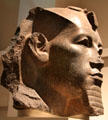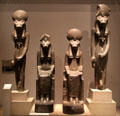 |  |  |  |
| Gallery of Egyptian antiquities at British Museum. London, United Kingdom. | Egyptian predynastic mudstone carved palette for grinding eye paint with hunters' scene (3250-3100 BCE - Naqada III) at British Museum. London, United Kingdom. | Details of Egyptian predynastic mudstone carved palette for grinding eye paint with hunters' scene (3250-3100 BCE - Naqada III) at British Museum. London, United Kingdom. | Painted limestone statue of Kaitep & his wife, Hetepheres (56th Dynasty - c2300 BCE) prob. from Giza at British Museum. London, United Kingdom. |
 |  |  |  |
| Colossal granite head of King Amenemhat III (12 Dynasty - c1830 BCE) from Bubastis at British Museum. London, United Kingdom. | Red granite seated statue of Sobekemsaf I (17th Dynasty - c1603 BCE) from Karnak at British Museum. London, United Kingdom. | Limestone statue of Amenhotep I (18th Dynasty - c1510 BCE) from Thebes at British Museum. London, United Kingdom. | Red granite standing statue either king Tuthmosis III or Amenhotep II (18th Dynasty - c1450 BCE) from Karnak at British Museum. London, United Kingdom. |
 |  |  |  |
| Four black granite figures of goddess Sakhmet (18th Dynasty - c1400 BCE) from Thebes at British Museum. London, United Kingdom. | Four black granite figures of goddess Sakhmet (18th Dynasty - c1400 BCE) from Thebes at British Museum. London, United Kingdom. | Limestone stela of Sobkhotpe (18th Dynasty - c1400 BCE) at British Museum. London, United Kingdom. | Red granite colossal head of a king (18th Dynasty - 1390? BCE) from Thebes at British Museum. London, United Kingdom. |
 |  |  |  |
| Upper part of colossal statue of Amenhotep III (18th Dynasty - c1370 BCE) from Thebes at British Museum. London, United Kingdom. | Upper part of seated granite statue of Ramesses II (19th Dynasty - c1270 BCE) from Thebes at British Museum. London, United Kingdom. | Mummy cartonnage case of woman named Tjentmutengebtiu (22th Dynasty - c900 BCE) from Thebes at British Museum. London, United Kingdom. | Details of Mummy cartonnage case of woman named Tjentmutengebtiu (22th Dynasty - c900 BCE) from Thebes at British Museum. London, United Kingdom. |
 |  |  |  |
| Four painted wooden dummy Canopic jars (too small for actual organs) (25th Dynasty - c700 BCE) at British Museum. London, United Kingdom. | Four calcite Canopic jars (26th Dynasty - c570-525 BCE) from Saqqara at British Museum. London, United Kingdom. | Reconstructed painting of Nebamun hunting birds with wife Hathepsut in marshes of Nile (18th Dynasty - c1350 BCE) from his tomb, Thebes at British Museum. London, United Kingdom. | Wall painting of Nebamun counting his cattle (18th Dynasty - c1350 BCE) from his tomb, Thebes at British Museum. London, United Kingdom. |
 |  |  |  |
| Polychrome glass cosmetic bottle in form of 'bulti'-fish (18th Dynasty - c1350 BCE) found under floor in house in el-Amarna, Egypt at British Museum. London, United Kingdom. | Ivory cosmetic box in form of duck with ducklings on her back (18th Dynasty - c1350 BCE) from Egypt at British Museum. London, United Kingdom. | Ancient Egyptian eye amulets (Wedjat falcon head of god Horus) to protect from harm at British Museum. London, United Kingdom. | Faience amulets of sons of Horus (26th Dynasty - c664 BCE or later)at British Museum. London, United Kingdom. |
 |  |  |  |
| Outer coffin of Hornedjitef, son of Nekhthorheb (Ptolemaic Dynasty - c240 BCE) from Asasif (Thebes) at British Museum. London, United Kingdom. | Coffin of Djedhor (Ptolemaic Dynasty - c250 BCE) from Akhmim at British Museum. London, United Kingdom. | Coffin of unknown man (Late Ptolemaic Dynasty or Roman period - 1stC BCE - 1stC CE) from Akhmim at British Museum. London, United Kingdom. | Rosetta Stone is inscribed with three versions of a decree: Ancient Egyptian in hieroglyphics & Demotic scripts plus Ancient Greek which was used to decode the top two writings. (Ptolemaic Dynasty - 196 BCE) at British Museum. London, United Kingdom. |
 |  |  |  |
| Rosetta Stone is inscribed with three versions of a decree: Ancient Egyptian in hieroglyphics & Demotic scripts plus Ancient Greek which was used to decode the top two writings. (Ptolemaic Dynasty - 196 BCE) at British Museum. London, United Kingdom. | Details of three ancient languages inscribed on Rosetta Stone at British Museum. London, United Kingdom. | Painted lime plaster mask of man shaped over his skull (Roman period - 100-170 CE) from Hu (Diopolis Parva) at British Museum. London, United Kingdom. | Romano-Egyptian mummy portrait of young man on limewood (80-120 CE) from Hawara at British Museum. London, United Kingdom. |
 |
|
|
|
| Mummy portrait of woman painted in encaustic on wood (Roman times c300-325 CE) from El-Rubajat in Fayum at British Museum. London, United Kingdom. |
|
|
|








